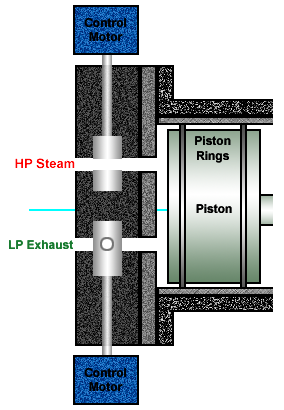Steam Engine Design/Rotating Valve
Main > Energy > Steam Engine
See also Electric Valves for Steam Engine
Gregor's Proposal
What about a totally linear steam engine? Linear alternator, and hydrodynamic bearings using water (tap off of the condensate return pump maybe) for the linear bearings. Easier to make a large expansion ratio in a single stage than with crankshafts. Mounted vertically to avoid the static axial load on the piston rod.
Electric valves: Suppose you take a ball valve. Make it so it can rotate continuously. Now attach a small brush-less motor or stepper motor. Make the hole through the ball very small and likewise with the input/output holes so that during a full rotation, only a very small fraction of the time is the valve "open". Have it rotate at the same frequency as the cycle frequency of a steam engine. Thus the valve opens and closes at just the right frequency. But it opens and closes non-abruptly and the full-open has a limited open area. Although that is similar to a bump valve. It also does not have to be a ball. Suppose it was a cylinder and rot with a slot in it instead, could be easier to make. A roller bearing with a slot in it might make a good valve bit thing. It can be made longer to make the full-open position have less constriction without affecting the open-time. Thus higher abruptness could be achieved... What about the steam trapped in the slot? probably not a problem?
Problems: the actuator has to be kept below the curie point of the material used, probably not hard. Come to think of it, the water would condense in any non-heated-by-the sun parts, an this could be taken advantage of a s a handy lubricant.
But the whole point is to be able to change the open time as a fraction of cycle time which requires that the outlet valve area be changed somehow. That could be added in some way, but might end up more complex than a similar variable-bump valve thing (but if the wear issues are too hard to solve with bump valves maybe it would be useful).
The key thing is the recognition that the timing stroke-to-stroke does not really change and therefore some sort of continuously rotating actuator can be used without the inertia being a problem.
Drawing
Analysis
The drawing above shows two rotating valves attached to control motors which are controlled by a computer such as the Arduino or similar. The top valve controls the flow of high pressure steam into the engine. The bottom controls release of low pressure exhaust steam. By having valves for both at the top of the cylinder, exhausting spent steam can be done with out pressurizing it. Thus, the engine does more work and will be more efficient overall.
Timing of the valves is critical, naturally. Some kind of shaft encoder will be needed to sense the position of the piston in the cylinder. Given a known position, the controller can cause the motors to open or close either the steam or exhaust valves. At speed, variable cutoff allows the steam engine to accelerate or decelerate. At a dead stop, it can be used to start the engine (unless the piston is at bottom dead center, in which case it must be moved manually).
The rotating cylinder valve needs a tight seal to avoid steam leaking around it when closed.
more thoughts
"The problem I was foreseeing with this is that the fraction of the cycle time that the valve is open or shut cannot be changed on the fly, but is fixed by the relative size of the hole in the rotating thing. The timing for exactly when the valve opens relative to the top-dead-center position of the piston can be changed of course easily on the fly, and so the charge of steam and therefore compression ratio can be varied in that way. But That might result in some thermodynamic losses? The steam expands once into the piston during the inital influx of steam, then gets recompressed and then expands again during the power stroke. Dunno enough thermodynamics to tell if this would be a serious problem, but it's maybe less than ideal.
I would have thought the ideal was to have the valve open at top deal center and stay open as the piston moves downwards, until shutting abruptly when the desired volume of steam has entered the chamber, minimizing the pressure drop that occurs across the valve during the process of allowing the charge of steam into the cylinder. gregor
